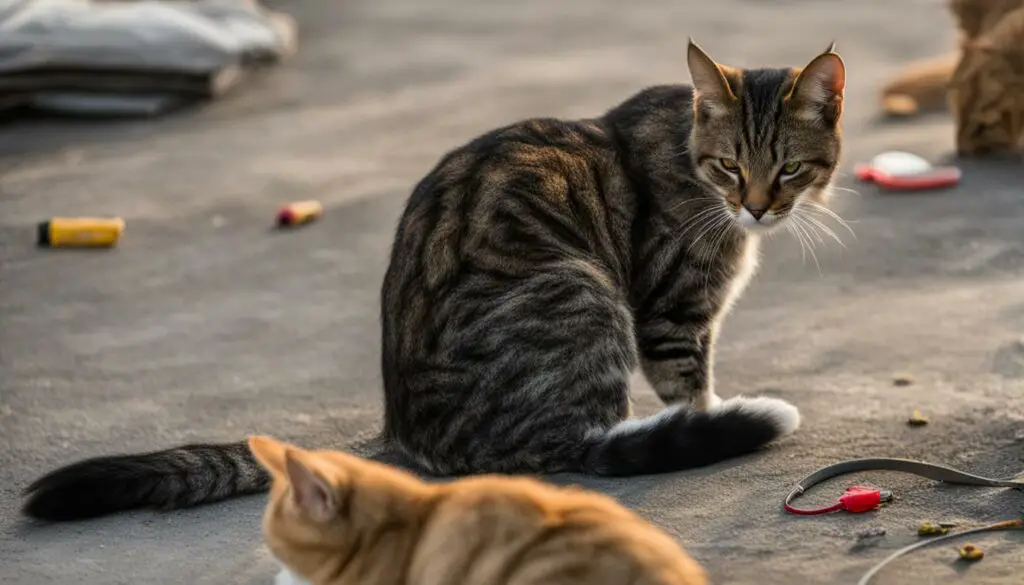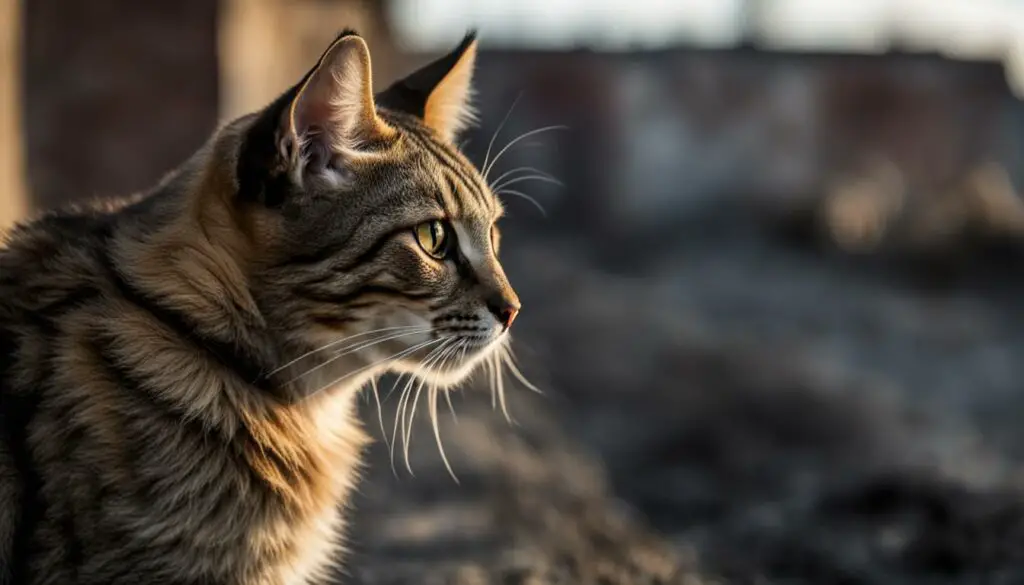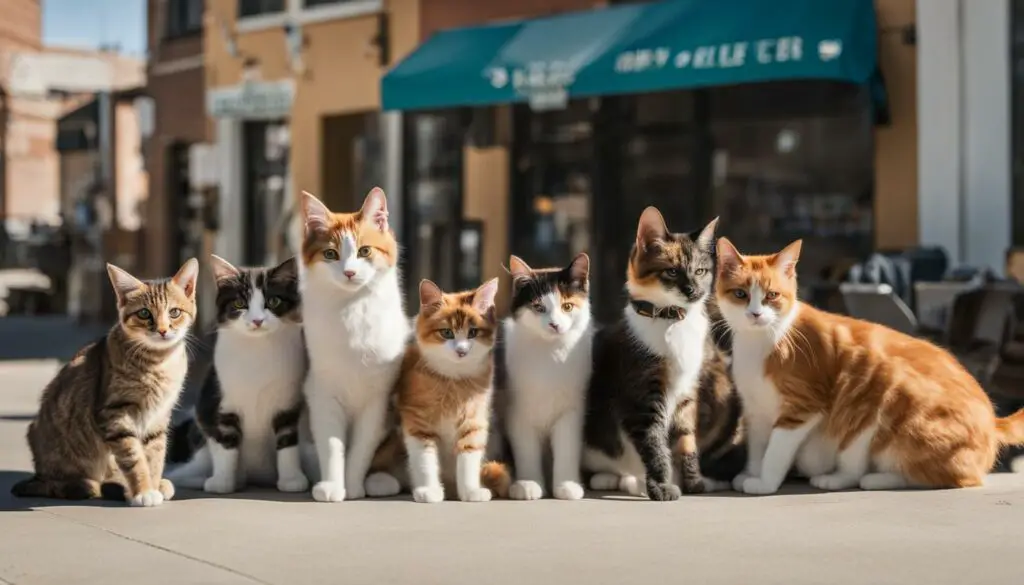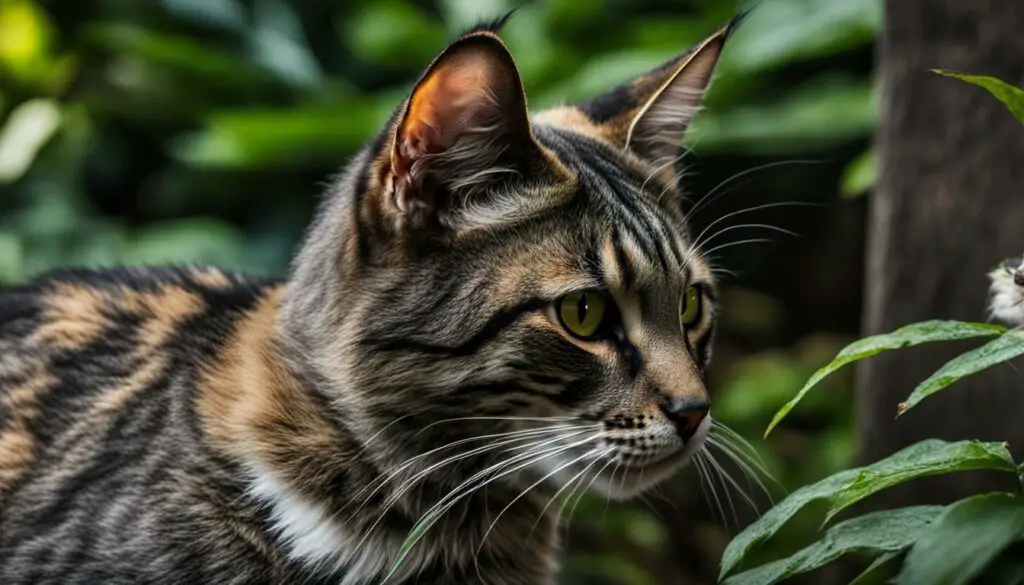Greetings, fellow cat lovers! Today, I want to delve into a fascinating topic that has captured the attention of pet owners and animal enthusiasts alike – the mysterious cat with both ears clipped. If you’ve ever come across a feral cat or a stray with a tipped ear, you may have wondered about the significance of this unique marking. Well, wonder no more! In this article, I will uncover the reasons behind ear clipping, shed light on its importance in feral cat management, and provide guidance on how to care for these remarkable cats.
Key Takeaways:
- A cat with both ears clipped indicates that it has undergone a trap-neuter-return (TNR) program.
- Ear tipping is a visual indicator that a cat is sterilized and vaccinated, helping control the feral cat population.
- Clipped ears make it easier to identify cats that still need to be spayed or neutered.
- Caring for a cat with clipped ears requires respecting their feral nature and providing basic necessities.
- TNR programs have numerous benefits, including reducing euthanasia rates and improving the health of feral cats.
The Practice of Ear Tipping
The practice of ear tipping is an important aspect of trap-neuter-return (TNR) programs aimed at managing feral cat populations. This procedure involves the removal of the tip of a cat’s ear while under anesthesia. The resulting clipped ear serves as a visual indicator that the cat has been sterilized and vaccinated, allowing caretakers and community members to easily identify cats that have already been through the TNR process.
By implementing TNR programs and using ear tipping as a marking method, communities can effectively control the feral cat population without resorting to euthanasia or unnecessary trapping. The ear tip not only signals that the cat is spayed or neutered, but it also signifies that the cat has received important vaccinations, ensuring their health and preventing the spread of diseases.

Community cat ear tipping is a valuable tool in feral cat management as it allows caretakers to focus their efforts on unaltered cats that still need to be sterilized. By targeting these cats, TNR programs can drastically reduce the number of feral cats and improve the overall well-being of these animals. The practice of ear tipping continues to evolve and gain recognition, providing a humane and effective solution to feral cat population management.
Table: Benefits of Ear Tipping in TNR Programs
| Benefit | Description |
|---|---|
| Identification | Ear tipping makes it easy to visually identify cats that have been through a TNR program, preventing unnecessary trapping and repeated sterilization. |
| Population Control | TNR programs help control the feral cat population by spaying or neutering cats, preventing the birth of unwanted litters. |
| Disease Prevention | By vaccinating cats during the TNR process, ear tipping helps prevent the spread of diseases among feral cat populations. |
| Community Awareness | Ear tipping serves as a visual cue for community members, letting them know that these cats have already been sterilized and vaccinated, fostering understanding and support. |
Identifying Clipped Ear Cats
Clipped ear cats can be easily recognized by the missing tip on one or both of their ears. This intentional marking serves as a clear indication that the cat has been involved in a trap-neuter-return (TNR) program. If you come across a cat with a clipped ear, it is likely that they are a feral or stray cat that has been spayed or neutered and released back into their environment.
Recognizing ear clipped cats is important for several reasons. Firstly, it allows caretakers to focus their efforts on unaltered cats that still need to be spayed or neutered, helping to control the feral cat population. Additionally, the presence of a clipped ear serves as a visual cue for community members, letting them know that these cats have already been sterilized and vaccinated.
To accurately identify a cat with a tipped ear, look for the missing tip on one or both ears. This distinctive marking is typically straight and neat, indicating that it was done intentionally. When you encounter a clipped ear cat, it is important to respect their feral nature and provide them with basic necessities such as food, water, and shelter. However, avoid trying to handle them unless necessary for their health and safety, as they are not accustomed to human contact.
Recognizing and understanding the significance of clipped ear cats plays a vital role in promoting responsible feral cat management. By supporting TNR efforts and ensuring the well-being of these cats from a distance, we can contribute to a more compassionate and sustainable future for feral cat communities.
The Importance of Clipped Ears in Feral Cat Management
Feral cat populations can pose significant challenges to communities, impacting ecosystems and wildlife. That’s why the practice of ear tipping, which involves removing the tip of a cat’s ear as part of trap-neuter-return (TNR) programs, plays a crucial role in feral cat management. Clipped ears serve as a visual cue, indicating that a cat has been sterilized and vaccinated.
By identifying cats that have already undergone TNR, caretakers can focus their efforts on unaltered cats that still need to be spayed or neutered. This targeted approach helps to control the feral cat population and minimize the negative impact on ecosystems and wildlife. Additionally, the presence of clipped ears provides valuable information to community members, letting them know that these cats have already been sterilized and vaccinated.
The significance of clipped ears goes beyond individual cats. It allows communities to track and manage feral cat populations more effectively, ensuring the continued success of TNR programs. By reducing unnecessary trapping and euthanasia, ear tipping contributes to a more compassionate and sustainable approach to feral cat management. It also helps dispel misconceptions and stigma associated with feral cats, raising awareness about their welfare and the need for responsible management.
| Ears Clipped | Benefits |
|---|---|
| Identifying Clipped Ear Cats | – Efficiently recognize cats that have been spayed or neutered – Focus efforts on unaltered cats that still need sterilization – Minimize unnecessary trapping and euthanasia |
| Community Awareness | – Inform community members that cats have been sterilized and vaccinated – Encourage support and understanding of feral cat management programs |
| Feral Cat Management | – Control and reduce feral cat populations – Minimize impact on ecosystems and wildlife – Promote a more compassionate and sustainable approach |
In conclusion, clipped ears play a vital role in feral cat management. They help identify cats that have been sterilized and vaccinated, allowing caretakers to focus on unaltered cats. This targeted approach reduces unnecessary trapping and euthanasia while effectively controlling the feral cat population. Additionally, the presence of clipped ears raises community awareness and promotes a more compassionate and sustainable approach to feral cat management.
The Benefits of TNR Programs
Trap-neuter-return (TNR) programs have proven to be highly beneficial for both cats and communities. By spaying or neutering feral cats, these programs effectively control the population and prevent the birth of unwanted litters. This not only reduces the strain on animal shelters but also minimizes euthanasia rates.
TNR programs also have a positive impact on the health and well-being of feral cats. By preventing certain diseases and reducing mating-related behaviors such as fighting and spraying, spaying or neutering helps improve the overall quality of life for these cats.

Furthermore, TNR programs contribute to the welfare of communities by addressing the issues associated with feral cat populations. By controlling the population through sterilization, these programs help mitigate the negative impact on ecosystems and wildlife. Additionally, TNR programs promote a more compassionate and humane approach to managing community cats, fostering a sense of responsibility and empathy among community members.
| Benefits of TNR Programs | Reasons |
|---|---|
| Population control | Prevents the birth of unwanted litters and reduces strain on animal shelters |
| Improved cat health | Prevents diseases and reduces mating-related behaviors |
| Positive impact on communities | Reduces negative impact on ecosystems and wildlife, promotes compassion and empathy |
Overall, TNR programs are a crucial component of responsible feral cat management. By spaying or neutering feral cats and addressing their welfare needs, these programs create a more sustainable and humane future for both cats and communities.
Caring for a Cat with Clipped Ears
If you come across a cat with both ears clipped, it is important to respect their feral nature. These cats are not accustomed to human contact and may be fearful or skittish. Provide them with food, water, and shelter, but avoid trying to handle them unless necessary for their health and safety. Instead, focus on supporting TNR efforts and ensuring their well-being from a distance.
Recognizing ear clipped cats can be helpful in identifying and managing feral cat populations. By understanding the significance of the clipped ears, you can play a role in promoting responsible feral cat management. If you encounter a cat with a clipped ear, it is a sign that the cat has been spayed or neutered and is part of a TNR program. This visual indicator allows caretakers and community members to easily identify cats that have already been altered and vaccinated.
While it may be tempting to try and tame a cat with clipped ears, it is essential to remember that these cats are best left to their feral lifestyle. By providing them with basic necessities and supporting TNR programs, you are helping to improve the lives of these cats and prevent unnecessary trapping and euthanasia. Take pride in being a compassionate supporter of feral cat welfare and contribute to the ongoing efforts of managing community cat populations.

The Mystery of the Clipped Ears Phenomenon
The reason behind clipping both ears of a cat remains somewhat of a mystery. While it is clear that ear tipping is essential for identifying and managing feral cat populations, the decision to clip both ears rather than just one is still unclear. Some speculate that it may simply be a standard practice to avoid confusion, while others believe it could serve as an additional visual cue for caretakers and community members.
Regardless of the exact reason, the practice of clipping both ears has become widely recognized as a symbol of responsible feral cat management. When I see a cat with both ears clipped, I know right away that they have been spayed or neutered and are part of a managed feral cat population. It’s a signal that these cats have been taken care of and are not contributing to the overpopulation of stray cats.
“The clipped ear signals to humans that this cat has been altered and is part of a managed feral cat population.”
The visual language of ear tipping allows for more effective management of feral cat colonies. It helps caretakers and community members quickly identify cats that have already been sterilized and vaccinated, allowing them to focus their efforts on cats that still need to be spayed or neutered. This streamlined approach reduces the likelihood of unnecessary trapping and euthanasia and promotes a more compassionate and humane method of feral cat population control.
While the exact origin of the practice may remain a mystery, the impact of ear tipping is undeniable. As we continue to advocate for trap-neuter-return programs and responsible feral cat management, the recognition and understanding of the clipped ears phenomenon will continue to grow, ultimately leading to better welfare for feral cats and more sustainable communities.
Additional Resources:
| Clipped Ears Phenomenon | Explanation |
|---|---|
| Reason for clipping both ears | Unknown, could serve as a visual cue or standard practice |
| Benefit of ear tipping | Identifying spayed/neutered cats and preventing unnecessary trapping |
| Impact on feral cat management | Streamlining efforts and reducing feral cat population |
The Psychology of Ear Tipping
Ear tipping, the practice of removing the tip of a cat’s ear, serves as a powerful symbol with both human and feline meanings. For humans, the clipped ear communicates that the cat has been altered and is part of a managed feral cat population. It acts as a visual indicator that this cat has undergone trap-neuter-return (TNR) and is no longer a potential mate for other cats. This communication helps to streamline feral cat management efforts and reduce unnecessary trapping and euthanasia.
But the psychology of ear tipping goes beyond human understanding. Feral cats themselves also receive a message through the clipped ear. They recognize that a cat with a clipped ear is different and may behave differently towards them. This awareness helps to establish boundaries and prevent unnecessary aggression. It allows feral cats to coexist with their altered counterparts in a more harmonious manner within their community.
“The clipped ear is like a badge of honor for feral cats. It signifies their survival in a challenging environment and their inclusion in a managed community. It’s a silent language that speaks volumes.”
The psychology of ear tipping extends to the broader community as well. When people see a cat with a clipped ear, they are more likely to understand the importance of responsible feral cat management and support TNR programs. The visual cue of the clipped ear sparks curiosity and encourages discussions about feral cat welfare. It serves as a tangible reminder that these cats are not disposable or unwanted but rather valued members of our shared environment.

Recognizing Ear Clipped Cats
If you encounter a cat with a clipped ear, it’s essential to understand that they are likely feral or stray cats that have been spayed or neutered and returned to their environment. Recognizing these cats is crucial for feral cat management efforts and can help direct resources towards unaltered cats that still need to be sterilized. By being aware of the significance of a clipped ear, you can contribute to the well-being and responsible care of these feline community members.
The Evolution of Ear Tipping Programs
The practice of ear tipping has significantly evolved over the years, gaining recognition and support as a crucial aspect of feral cat management. Communities and animal welfare organizations have embraced dedicated ear tipping programs, paving the way for more effective trap-neuter-return (TNR) efforts. By implementing these programs, communities can control feral cat populations while promoting a humane approach to managing community cats.
Ear tipping programs have seen enhancements in awareness and collaboration, with increased resources and support. This evolution has led to better tracking and management of feral cat populations, ensuring the success of TNR programs. It has also contributed to dispelling misconceptions and stigma surrounding feral cats, raising public awareness about their welfare and the need for responsible management.

As TNR efforts continue to grow and gain momentum, ear tipping remains the most effective and widely recognized method for identifying and tracking feral cats. While efforts are being made to explore alternative identification methods, ear tipping continues to be the preferred choice due to its simplicity and reliability. Ongoing education and advocacy are crucial to driving the future of TNR and ensuring the well-being of feral cat communities.
Cat Ear Clipping in Popular Culture
Clipped ear cats, with their distinctive appearance, have made their way into popular culture, becoming iconic symbols in various forms of media. From cartoons to art pieces, these feline figures with both ears clipped have gained recognition and awareness, shedding light on the importance of responsible feral cat management and supporting trap-neuter-return (TNR) programs.
These cats have become beloved characters in cartoons, often depicted as street-smart, independent, and resilient. Their clipped ears serve as a visual representation of their unique background and the challenges they have overcome. Artists and illustrators have also embraced this imagery, incorporating it into their works to raise awareness about feral cats and the need for their protection.

In addition to cartoons and art, clipped ear cats have also found their place in popular culture through merchandise and memes. T-shirts, mugs, and other products featuring these distinctive cats have become popular among cat lovers and animal enthusiasts, creating conversations and spreading awareness about TNR programs and the importance of responsible cat ownership.
Table: Famous Examples of Clipped Ear Cats in Popular Culture
| Character | Show/Movie |
|---|---|
| Tom | Tom and Jerry |
| Oliver | Oliver & Company |
| Toulouse | The Aristocats |
| Top Cat | Top Cat |
“Clipped ear cats have become beloved characters in cartoons, often depicted as street-smart, independent, and resilient.”
Through their presence in popular culture, clipped ear cats have become ambassadors for the feral cat population, raising awareness about their unique needs and the importance of feral cat management. By showcasing these cats in a positive light, popular culture plays a role in dispelling misconceptions and promoting a more compassionate and understanding approach to feral cat care.
These iconic characters serve as reminders that every cat, regardless of their background, deserves love, care, and respect. By supporting TNR programs and promoting responsible pet ownership, we can ensure a brighter future for both domesticated and feral cats alike.
The Continuing Impact of Clipped Ears
Ear tipping programs have had a significant and ongoing impact on feral cat management. By marking cats with clipped ears, communities are better able to track and manage their populations, ensuring the continued success of trap-neuter-return (TNR) programs. This practice plays a crucial role in reducing the feral cat population and maintaining the overall welfare of these cats.
The visual cue provided by ear tipping allows caretakers to distinguish between cats that have already been spayed or neutered and those that still need to undergo the procedure. This targeted approach not only helps control the population of feral cats but also avoids unnecessary trapping and euthanasia. With the identification of clipped ear cats, resources and efforts can be directed towards unaltered cats, ensuring that they receive the necessary veterinary care.
In addition to its practical benefits, ear tipping also helps dispel misconceptions and stigma associated with feral cats. By raising awareness about the importance of responsible management and the welfare of these cats, communities can foster a more compassionate approach towards their care. The practice of ear tipping sends a clear message that community cats are being actively managed and that their well-being is a priority.

In conclusion, the impact of ear tipping goes beyond individual cats. It is a symbol of responsible feral cat management and the success of TNR programs. By continuing to support and promote these programs, we can ensure the continued well-being of feral cat populations and create a more compassionate future for these animals.
The Future of Ear Tipping
As the understanding and support for TNR programs continue to grow, the future of ear tipping appears promising. Efforts are being made to refine the technique and explore alternative identification methods, but currently, ear tipping remains the most effective and widely recognized way to identify and track feral cats. Ongoing education and advocacy will play a crucial role in shaping the future of TNR and ensuring the well-being of feral cat communities.
Recognizing ear clipped cats will continue to be important for both caretakers and community members. The distinctive ear tip serves as a visual cue, indicating that a cat has been sterilized and vaccinated. This knowledge allows caretakers to focus their efforts on unaltered cats that still require attention, reducing the time and resources spent on already managed cats. It also provides community members with reassurance that these cats are part of a managed population, reducing unnecessary concerns or interventions.
While there is ongoing research to explore alternative identification methods, ear tipping remains the most practical and cost-effective solution. Other methods, such as microchipping or collar tags, may not be as suitable for feral cats due to the challenges of trapping and handling these animals. Ear tipping, on the other hand, can be easily done during the spay/neuter surgery, causing minimal stress and discomfort to the cats. Its simplicity and visibility make it an ideal choice for identifying and managing feral cat populations.
To ensure the future of TNR programs and the continued success of ear tipping, it is essential that we continue to raise awareness and gather support. By educating communities about the benefits of TNR, we can foster a more compassionate and sustainable approach to feral cat management. Supporting local TNR initiatives, promoting responsible pet ownership, and advocating for humane practices will all contribute to the future well-being of feral cat populations.

| Advantages of Ear Tipping | Challenges of Ear Tipping |
|---|---|
|
|
Conclusion
In conclusion, the presence of a cat with both ears clipped is not a mystery anymore. This unique identification practice, known as ear tipping, plays a vital role in feral cat management and trap-neuter-return (TNR) programs. The intentional removal of the tip of a cat’s ear while under anesthesia serves as a visual indicator that the cat has been sterilized and vaccinated.
Recognizing a clipped ear cat is easy, as the missing tip on one or both of their ears distinguishes them as feral or stray cats that have undergone the TNR procedure. This identification system helps caretakers focus their efforts on unaltered cats, reducing the feral cat population and preventing unnecessary trapping and euthanasia.
The benefits of TNR programs, facilitated by ear tipping, are numerous. These programs not only control the feral cat population, preventing the birth of unwanted litters, but also improve the cats’ health and well-being. By preventing certain diseases and reducing mating-related behaviors, TNR programs contribute to a more compassionate approach to feral cat management.
As we look to the future, it is clear that ear tipping will remain an essential aspect of feral cat management. While efforts are being made to refine the technique and explore alternative identification methods, ear tipping continues to be the most effective and widely recognized way to track and manage feral cat populations. By supporting TNR efforts and raising awareness about responsible feral cat management, we can create a more compassionate and sustainable future for these cats.
FAQ
Why do some cats have both ears clipped?
Cats with both ears clipped have most likely been involved in a trap-neuter-return (TNR) program, where feral cats are sterilized and released to manage populations.
How can I recognize a cat with clipped ears?
Clipped ear cats can be easily identified by the missing tip on one or both of their ears, which serves as a visual indicator that they have been sterilized and vaccinated.
What is the purpose of ear tipping in feral cat management?
Ear tipping helps caretakers and community members identify cats that have already been TNR’d, allowing them to focus on unaltered cats that still need to be spayed or neutered.
What are the benefits of TNR programs?
TNR programs help control feral cat populations, prevent the birth of unwanted litters, reduce euthanasia rates, and improve the health and well-being of feral cats.
How should I care for a cat with clipped ears?
If you come across a cat with both ears clipped, it’s important to respect their feral nature and provide them with food, water, and shelter. Avoid handling them unless necessary for their health and safety.
Why are both ears clipped instead of just one?
The reason behind clipping both ears remains somewhat unknown, but some speculate that it may be a standard practice to avoid confusion and serve as an additional visual cue.
What is the significance of ear tipping in feral cat management?
Ear tipping allows communities to track and manage feral cat populations, reduce unnecessary trapping and euthanasia, and raise awareness about responsible cat welfare.
How has ear tipping evolved over time?
Ear tipping programs have gained recognition and support, with more organizations and communities implementing trap-neuter-return efforts to manage feral cat populations.
What is the impact of ear tipping beyond individual cats?
Ear tipping helps dispel misconceptions and stigma associated with feral cats, fostering a more compassionate and humane approach to their management.
Will ear tipping remain a vital aspect of feral cat management in the future?
While efforts are being made to refine the technique and explore alternative methods, ear tipping currently remains the most effective and widely recognized way to identify and track feral cats.








